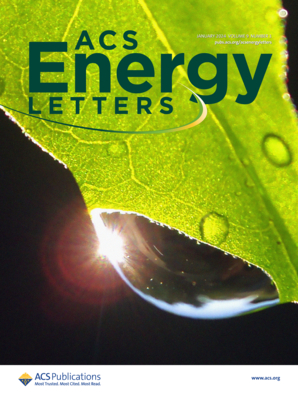Elucidating Charge Carrier Solvation in Biredox Eutectic Electrolytes for Nonaqueous Symmetrical Organic Redox Flow Batteries
IF 19.3
1区 材料科学
Q1 CHEMISTRY, PHYSICAL
引用次数: 0
Abstract
Charge carrier solvation is crucial for mass transfer rates and redox kinetics of redox couples in organic redox flow batteries (ORFBs), yet it remains underexplored. This study employs molecular dynamics simulations to investigate charge carrier solvation in biredox eutectic electrolytes (BEEs) under diverse solvent and salt conditions. Results demonstrate that acetonitrile (ACN) molecules preferentially occupy the primary solvation shell of the bis(trifluoromethanesulfonimide) anions (TFSI–) in the catholyte and the tetrabutylammonium cations (TBA+) in the anolyte, forming charge carrier solvation, thus decoupling the molecular interactions within the BEEs and accelerating the redox kinetics in ORFBs. With an optimized ACN-TBATFSI electrolyte, a prototype symmetrical flow cell can achieve a high output voltage of 2.35 V, high material utilization of 93%, and stable cyclability with a capacity retention rate of 99.97% per cycle after 1200 cycles. This work highlights the potential of modulating the charge carrier solvation to enhance the electrochemical performance of ORFBs.

求助全文
约1分钟内获得全文
求助全文
来源期刊

ACS Energy Letters
Energy-Renewable Energy, Sustainability and the Environment
CiteScore
31.20
自引率
5.00%
发文量
469
审稿时长
1 months
期刊介绍:
ACS Energy Letters is a monthly journal that publishes papers reporting new scientific advances in energy research. The journal focuses on topics that are of interest to scientists working in the fundamental and applied sciences. Rapid publication is a central criterion for acceptance, and the journal is known for its quick publication times, with an average of 4-6 weeks from submission to web publication in As Soon As Publishable format.
ACS Energy Letters is ranked as the number one journal in the Web of Science Electrochemistry category. It also ranks within the top 10 journals for Physical Chemistry, Energy & Fuels, and Nanoscience & Nanotechnology.
The journal offers several types of articles, including Letters, Energy Express, Perspectives, Reviews, Editorials, Viewpoints and Energy Focus. Additionally, authors have the option to submit videos that summarize or support the information presented in a Perspective or Review article, which can be highlighted on the journal's website. ACS Energy Letters is abstracted and indexed in Chemical Abstracts Service/SciFinder, EBSCO-summon, PubMed, Web of Science, Scopus and Portico.
 求助内容:
求助内容: 应助结果提醒方式:
应助结果提醒方式:


